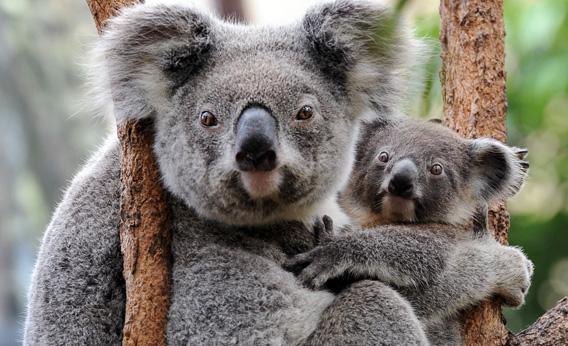 When koalas infected with the koala retrovirus reproduce, they pass the viral DNA along with their own to their offspring.
When koalas infected with the koala retrovirus reproduce, they pass the viral DNA along with their own to their offspring. Photo by Torsten Blackwood/AFP/Getty Images.
To understand what it means to be human, you have to understand koalas. Or, to be more precise, you have to understand how they are dying from a bizarre viral outbreak that has been raging for the past 150 years or so. The koalas are now going through something our ancestors experienced 31 times over the past 60 million years. And those ancient viral outbreaks have helped to make us who we are today.
Australian biologists discovered the koala outbreak in 1988. They were examining the blood of a koala dying of leukemia when they came across a virus infecting its white blood cells. The koala retrovirus, as it is now known, made its hosts sick in much the same way the feline leukemia virus sickens cats. It inserted its genes into host immune cells, which then produced new viruses. The infection also caused the cells to replicate at a frenzied rate. Once the scientists had found the koala retrovirus in one koala, they looked for it in others, and they soon found it all over the koala?s range?the entire eastern side of Australia.
Koalas had long been known to have terrible health. One survey estimated that leukemia and lymphoma were responsible for up to 80 percent of koala deaths. The discovery of the koala retrovirus made sense of this cancer epidemic. It also explained why koalas were getting devastated by chlamydia, a sexually transmitted bacterium. By turning koalas? immune systems cancerous, the virus was leaving the koalas open to infection by other pathogens.
Scientists who went rummaging through koala skins in museums found genes from the retrovirus as far back as the mid-1800s, but that still makes it a fairly young outbreak. To figure out where the koala retrovirus came from, scientists have compared its genes to those of other species of viruses. One of the most similar viruses to it infects the grassland mosaic-tailed rat of Australia. The virus may well have been carried from the rats to the koalas by a mosquito or a tick.
Once the koalas picked up the retrovirus, they began to spread it among themselves. After young koalas are weaned but before they start dining on eucalyptus leaves, they feed on their mother?s feces?feces that may be laden with koala retroviruses. The epidemic appears to have started in northern Australia, where today the virus is ubiquitous. Since then, it has spread southward, even jumping to islands off the coast of Australia?presumably in the guts of mosquitos.
As it spreads, the koala retrovirus is doing something else: It is genetically merging with the koala itself. In many koalas, the virus? genes aren?t present just in the immune cells. The koalas carry the virus genes in every cell of their bodies, from their vestigial tails to their snub noses and in every organ in between. When these koalas reproduce, they pass the viral DNA along with their own to their offspring.
These koala-virus hybrids are the result of a peculiar sort of infection. Every now and then, the koala retrovirus ends up infecting an egg or a sperm. It inserts its genes into the DNA of the host cell, as it normally does. But instead of churning out new viruses that infect other cells, the infected sex cell does something else: It becomes a new koala. As a fertilized, virus-carrying egg divides and grows into an embryo, the koala retrovirus DNA is copied into every new cell. And when that virally infused koala is born and grows up and reproduces, it passes the virus down as well. In many cases, the inherited virus DNA still has the potential to make new viruses that can infect other koalas and trigger cancer in them.
The koala retrovirus continues to spread today, attacking the last uninfected populations. In years to come, it will kill off many more animals while inserting itself into the DNA of the survivors. It?s likely that at some point every koala left on Earth will carry the virus? genes. And in future generations, those genes will gradually mutate and lose their ability to make new viruses. Eventually, the koala retrovirus will become extinct. All that will remain will be its imprisoned DNA.
Like Emily Yoffe's Dear Prudence Column on Facebook:
Source: http://feeds.slate.com/click.phdo?i=7a321cdcdc851cc275f363898ee1ab7c
dark shadows trailer nate mcmillan clooney arrested southern miss rod blagojevich rod blagojevich uconn
No comments:
Post a Comment
Note: Only a member of this blog may post a comment.